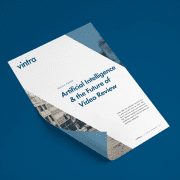The Big Problem with Video Review

The Truth about Video Review
- 20 minutes of sustained video review on a single screen, leads to a 95% loss of visual perceptivity
- After 22 minutes, operators viewing video begin to suffer from “video blindness”
- Pigeons are better suited to monitor video
The Rescue Squab
During the late 1970s and early 80s, the U.S. Coast Guard experimented with a new technique for open water rescues. They called the operation, Project Sea Hunt.
Pigeons were trained to peck an electrical key every time they spotted something in the water, and then placed in plexiglass pods affixed to the bottom of helicopters that flew above the ocean. Cute, right? More than just cute. Pigeons successfully spotted the target on the first pass 90% of the time, compared to only 38% of the time for humans. In fact, pigeons spotted the target before the human pilot did 84% of the time.
What’s the real problem? It’s not that pigeons are smarter than humans, but that humans are not built for long-term singular focus. Studies found that a human doing the exact same thing as a pigeon, searching the blue ocean for an orange life raft, would miss a raft nearly the size of a basketball court after only 20 – 30 minutes of sustained focus. All they saw was the ocean.
Read the White Paper, Artificial Intelligence and the Future of Video Review
{{cta(‘989972de-36e7-473a-922f-07715946c9cd’)}}
Video Review or Video Blindness?
The same holds true for video review. After twenty minutes analyzing or reviewing video on a single screen, humans lose 95% of their visual perceptivity. Add a second screen for an operator to monitor, and that rate is cut in half. Other studies have found that after twelve minutes of sustained video monitoring, an operator will miss 45% of screen activity, while after twenty-two minutes the operator begins to suffer from “video blindness” and will miss 95% of activity.
How many clues have been missed by operators, investigators, or analysts simply because humans are incapable of successfully performing the task for the required amount of time? It is not a failure of the analyst, it’s simply how we are wired as humans and a broken work process.
One logical solution is to add more operators, thereby cutting down the amount of video each person is required to monitor or review. Unfortunately, hiring additional operators is costly and still fails to address the fundamental problem plaguing the process: our limited attention span, fatigue, and even more basic complications like interruptions and distractions that make human video monitoring problematic.
Ready to change the way you think about security and investigations?
{{cta(‘b7a32974-cb07-4e5a-8dd8-2a867c918942’)}}
The Solution?
FuclrumAI, Vintra’s AI-powered video analytics solution, takes the human element out of the review process. Instead of detectives and investigators being forced to sit for hours-on-end trying to find the needle in a haystack of videos, FulcrumAI burns the haystack down around the needle. For real-time video monitoring, alerts and alarms are funneled to the operator so that actions can be taken as incidents occur, or to even stop them before it happens. There’s too much data available in video, and too many cameras to get it from, to leave peoples’ and businesses’ safety and security to the birds.
Subscribe to the blog for more Vintra news and the latest in ArtificialIntelligence.











Leave a Reply
Want to join the discussion?Feel free to contribute!